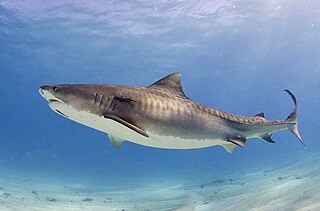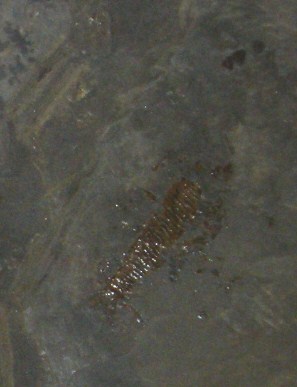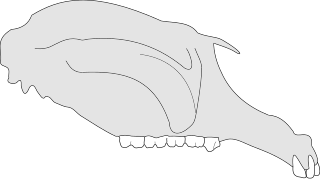
Chondrichthyes is a class of jawed fish that contains the cartilaginous fish or chondrichthyians, which all have skeletons primarily composed of cartilage. They can be contrasted with the Osteichthyes or bony fish, which have skeletons primarily composed of bone tissue. Chondrichthyes are aquatic vertebrates with paired fins, paired nares, placoid scales, conus arteriosus in the heart, and a lack of opecula and swim bladders. Within the infraphylum Gnathostomata, cartilaginous fishes are distinct from all other jawed vertebrates.

Galeocerdo is a genus of ground shark. Only a single species, G. cuvier, the tiger shark is extant. The earliest fossils date back to the early Eocene epoch, (Ypresian), around 56–47.8 Million years ago. While historically considered a member of the requiem shark family Carcharhinidae, it is currently considered to be the only member of the family Galeocerdonidae. While this genus was historically considered diverse, including 21 extinct species, morphometric analysis conducted in 2021 suggested that the diversity of the genus included only 5 extinct species much lower than previously assumed. The oldest fossils of the extant G. cuvier date to the middle Miocene.

Carcharhinus is the type genus of the family Carcharhinidae, the requiem sharks. One of 12 genera in its family, it contains over half of the species therein. It contains 35 extant and eight extinct species to date, with likely more species yet to be described.

The Barstovian North American Stage on the geologic timescale is the North American faunal stage according to the North American Land Mammal Ages chronology (NALMA), typically set from 16,300,000 to 13,600,000 years BP, a period of 2.7 million years. It is usually considered to overlap the Langhian and Serravallian stages of the Middle Miocene. The Barstovian is preceded by the Hemingfordian and followed by the Clarendonian NALMA stages.
The Mustersan age is a period of geologic time within the Eocene epoch of the Paleogene, used more specifically within the South American land mammal age (SALMA) classification. It follows the Casamayoran and precedes the Divisaderan age.
The Deseadan age is a period of geologic time within the Oligocene epoch of the Paleogene to the Early Miocene epoch of the Neogene, used more specifically within the SALMA classification of South America. It follows the Tinguirirican and precedes the Colhuehuapian age.
The Santacrucian age is a period of geologic time within the Early Miocene epoch of the Neogene, used more specifically with SALMA classification in South America. It follows the Colhuehuapian and precedes the Friasian age.
The Laventan age is a period of geologic time within the Middle Miocene epoch of the Neogene, used more specifically within the SALMA classification in South America. It follows the Colloncuran and precedes the Mayoan age.

Habroichthys is an extinct genus of prehistoric bony fish that lived during the early Ladinian stage of the Middle Triassic epoch, 242 to 232 million years ago. It has been found in Austria, China, Italy, Slovenia, and Switzerland. It was a small fish measuring 26 cm (10 in) long.

Allolepidotus is an extinct genus of prehistoric neopterygian ray-finned fish from the Middle Triassic epoch. It is referred to the halecomorph order Panxianichthyiformes.
The Castle Hayne Limestone is a geologic formation in North Carolina. It consists of cobble to pebble sized clasts, usually rounded, coated with phosphate and glauconite in a limestone matrix. The Castle Hayne Limestone is known for containing fossils dating back to the Paleogene period. It preserves many of North Carolina's renowned Eocene fossils. It is named after the locality of Castle Hayne in New Hanover county, though the formation itself stretches over several counties.
The Bashi Formation is a geologic formation in Alabama and Mississippi. It is named for Bashi Creek in northern Clarke County, Alabama, which cuts through some of its exposures. It preserves fossils dating back to the Eocene period, or Wasatchian in the NALMA classification.
Micromomyidae (Micromomids) is a family of extinct plesiadapiform mammals that include some of the earliest known primates. The family includes five genera that lived from the Paleocene epoch into the early Eocene epoch.

Miocochilius is an extinct genus of small notoungulate mammals (typotheres) native to South America. The genus lived during the Middle Miocene epoch. The genus contains two described species, the type species M. anomopodus described in 1953 by Ruben Arthur Stirton and M. federicoi, described and included in the genus by Darin A. Croft.

Propalorchestes is a fossil genus of palorchestid marsupial that existed in Australia during the Miocene epoch.
Belemnobatis is an extinct genus of ray from the Mesozoic era. As with most basal batoids, its exact placement within its order and the relationships between species are poorly understood. In addition, the line between this genus and Spathobatis is unclear. It is possible this genus is a wastebasket taxon. It is known from many sites of both Jurassic and Cretaceous age throughout Europe and a single Asian occurrence in the middle Jurassic of Thailand.






